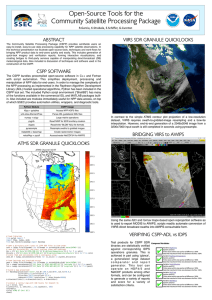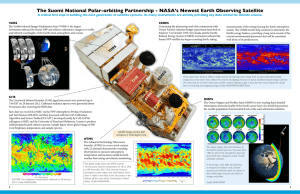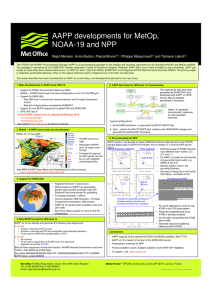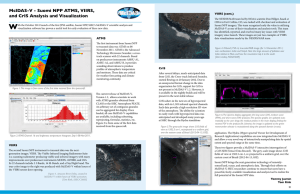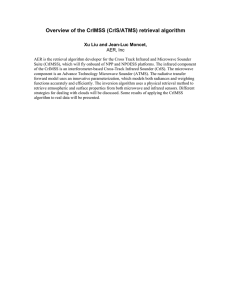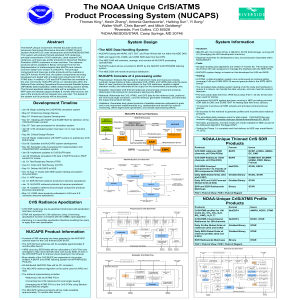AAPP status report and initial experiences with processing NPP data
advertisement
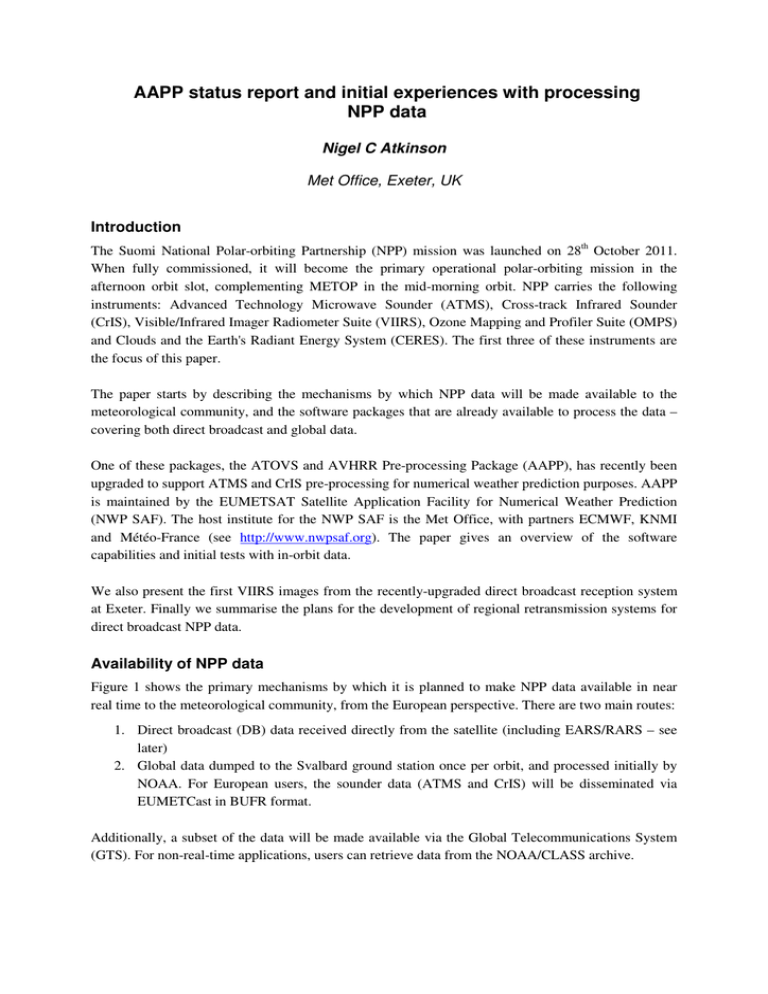
AAPP status report and initial experiences with processing NPP data Nigel C Atkinson Met Office, Exeter, UK Introduction The Suomi National Polar-orbiting Partnership (NPP) mission was launched on 28th October 2011. When fully commissioned, it will become the primary operational polar-orbiting mission in the afternoon orbit slot, complementing METOP in the mid-morning orbit. NPP carries the following instruments: Advanced Technology Microwave Sounder (ATMS), Cross-track Infrared Sounder (CrIS), Visible/Infrared Imager Radiometer Suite (VIIRS), Ozone Mapping and Profiler Suite (OMPS) and Clouds and the Earth's Radiant Energy System (CERES). The first three of these instruments are the focus of this paper. The paper starts by describing the mechanisms by which NPP data will be made available to the meteorological community, and the software packages that are already available to process the data – covering both direct broadcast and global data. One of these packages, the ATOVS and AVHRR Pre-processing Package (AAPP), has recently been upgraded to support ATMS and CrIS pre-processing for numerical weather prediction purposes. AAPP is maintained by the EUMETSAT Satellite Application Facility for Numerical Weather Prediction (NWP SAF). The host institute for the NWP SAF is the Met Office, with partners ECMWF, KNMI and Météo-France (see http://www.nwpsaf.org). The paper gives an overview of the software capabilities and initial tests with in-orbit data. We also present the first VIIRS images from the recently-upgraded direct broadcast reception system at Exeter. Finally we summarise the plans for the development of regional retransmission systems for direct broadcast NPP data. Availability of NPP data Figure 1 shows the primary mechanisms by which it is planned to make NPP data available in near real time to the meteorological community, from the European perspective. There are two main routes: 1. Direct broadcast (DB) data received directly from the satellite (including EARS/RARS – see later) 2. Global data dumped to the Svalbard ground station once per orbit, and processed initially by NOAA. For European users, the sounder data (ATMS and CrIS) will be disseminated via EUMETCast in BUFR format. Additionally, a subset of the data will be made available via the Global Telecommunications System (GTS). For non-real-time applications, users can retrieve data from the NOAA/CLASS archive. Figure 1: Mechanisms for the distribution of NPP data It is planned that the EUMETCast distribution route will be available in pre-operational form in June 2012; some test transmissions have already been performed. Processing packages Table 1 lists some of the free processing packages that are already available for use with NPP data. Table 1: Processing packages for NPP data. Note: RDR=Raw Data Record, SDR=Sensor Data Record Package Use Where to get it RT-STPS v5.1a (NASA DRL package with UW patch) Simulcast v5.0 DB: create RDR from raw telemetry UW (details in CSPP Installation Guide) DB: Quick-look viewer CSPP v1.1 DB: RDR to SDR (VIIRS, ATMS, CrIS) ATMS and CrIS preprocessing NASA DRL http://directreadout.sci.gsfc.nasa.gov/ UW http://cimss.ssec.wisc.edu/cspp/ NWP SAF http://www.nwpsaf.org AAPP v7.1 Pytroll (from DMI and SMHI) Python tool for VIIRS imagery Note: Users of AAPP v6 need to reregister for AAPP v7 http://pytroll.org/ AAPP v7.1 AAPP v7.1 was released on 2nd March 2012. It performs the following functions with respect to NPP data: • Ingests SDR files in HDF5 format, for ATMS/CrIS. These files are an output from CSPP. They are converted to an internal AAPP format. • Ingests ATMS/CrIS BUFR files (see Figure 1) • BUFR encoding for ATMS/CrIS SDR files • ATMS spatial filtering, to reduce noise and improve inter-channel consistency • • • Map ATMS to CrIS (to generate “level 1d” product) Generate derived ATMS cloud/surface information BUFR encoding for the level 1d product For full details on this functionality, see NWP SAF (2011). Some initial results from ATMS NE∆T check The ATMS SDR files contain an internal estimate of the NE∆T, based on calibration view readings. For this test we compare those estimates with an estimate based on the local variability of the calibrated brightness temperatures. In Figure 2 we show histograms of the standard deviation of 6×6 samples for channels 9 to 14 – for the raw SDR data and also for spatially filtered data (using the Fourier method described in NWP SAF (2011)). As expected, the distributions have a “tail” due to the presence of spatial inhomogeneities (e.g. cloud), but there is reasonably good agreement between the peak of the histogram and the nominal NE∆T. Spatial filtering has reduced the noise by a factor ~3. Figure 2: ATMS noise histograms: black – std. dev. of 6×6 samples of the SDR; red – std. dev. of 6×6 samples of the filtered SDR; blue vertical line – internal NE∆T estimate. Effect of spatial filtering on inter-channel consistency The natural beam width of ATMS channels 1 and 2 is much larger than that of channels 3-15 (5.2° versus 2.2°). The AAPP spatial filtering module can be used to broaden the effective beam width of channels 3-15 and to narrow (slightly) that of channels 1-2. The actual manipulation can be set by the user, but here we aim for 3.3° for both groups of channels. Figure 3: Left: BT difference between channel 3 and 2, for raw SDR. Right: After AAPP spatial filtering Figure 4: BT difference for NOAA-19 AMSU-A channels 3 and 2 Looking at Figure 3, it is apparent that the right hand (spatially filtered) difference image has a more physically realistic representation of the clouds (e.g. eliminating the alternating dark/light patches in the Pacific Ocean), and has sharpened the Great Lakes in the northern part of the image. A comparable difference image for NOAA-19 AMSU-A is shown in Figure 4 (AMSU-A has 3.3° beam width for all channels). An aim of this technique is to facilitate the use of channels 1 and 2 as part of the quality control for assimilation of the temperature sounding channels. Model comparisons Comparisons between ATMS BTs and those predicted from NWP models are presented in Amy Doherty’s poster 1.18. In the near future it is planned to run assimilation trials at the Met Office using ATMS data. Initial results from CrIS To date, only technical checks have been done at the Met Office using CrIS data – e.g. verification that the AAPP functionality works correctly: • • • Decoding the SDR (hdf5 format) BUFR encoding and decoding Map ATMS to CrIS Assimilation trials are planned for when the routine data flow via EUMETCast is available. Reception of Direct Broadcast NPP data and generation of VIIRS imagery The Met Office’s X-band reception system was upgraded during early March 2012. Figure 5 shows one of the first VIIRS images captured. The raw data were processed to SDR level using CSPP (Table 1), and the imagery generated using in-house reprojection software. Figure 5: VIIRS false-colour image generated at the Met Office, Exeter Regional distribution of direct broadcast NPP data As part of the EUMETSAT Advanced Retransmission System (EARS), NPP data from several direct readout stations (see Figure 6) will be distributed to users via EUMETCast. Each station will run CSPP, together with AAPP to do the BUFR encoding of the sounder data. ATMS, CrIS and VIIRS data will be disseminated by this system. The timeliness goal is 30 minutes. Figure 6: Initial EARS-NPP network A similar initiative is planned by the WMO RARS programme, to cover other areas of the globe. Conclusions Data from the NPP satellite are being evaluated by the meteorological community. Processsing packages are in place to allow users to make use of the data. The indications so far are that these packages, and the instruments themselves, are working well. Acknowledgements Many people have been involved in this work, e.g. in data provision, software development, software testing and data analysis, including: • Anna Booton, Amy Doherty, Ian Brown, John Eyre, Simon Keogh, Bryan Conway (Met Office) • Pascal Brunel, Tiphaine Labrot, Pascale Roquet, Philippe Marguinaud, Lydie Lavanant (Météo-France) • Christelle Ponsard, Anders Soerensen, Simon Elliott, Thomas Heinemann (EUMETSAT) • Chris Barnet, Andrew Collard, Yi Song (NOAA) • Liam Gumley, Kathy Strabala (CIMSS) • Niels Bormann, Bill Bell (ECMWF) • Steve Swadley (NRL) References NWP SAF, 2011: Annex to AAPP scientific documentation: Pre-processing of ATMS and CrIS, document NWPSAF-MO-UD-027, available from the AAPP page at http://www.nwpsaf.org.
